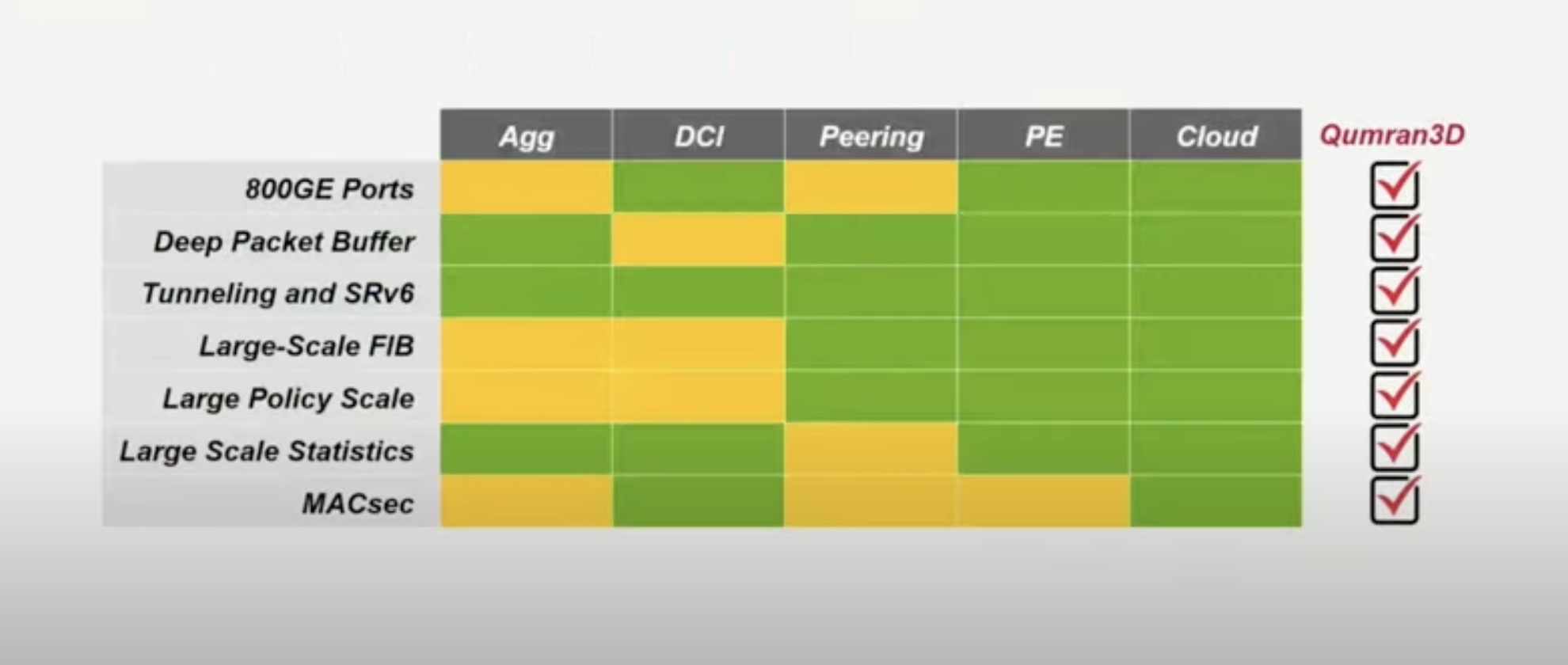There are more than 5 billion internet users in the world today. The number is growing by a staggering 1 million year-on-year. What’s even more mind-blowing is that researchers believe that these numbers are below the actual adoption rates.
Service provider networks have realized significant milestones in connecting subscribers over long distances. From mere providers, they have been risen to the status of technology enablers. So as more subscribers sign up and the demand for round-the-clock service soars, companies are on the lookout for high-end routing solutions to tackle the usage needs and support breakthrough technologies like AI and edge computing.
Introducing Qumran3D
At the recent Cloud Field Day event, Broadcom introduced Qumran3D, the industry’s first 5nm 25.6 Tb/s single-chip router. Launched in the fourth quarter of 2023, Qumran3D presents several advanced and powerful routing capabilities to power single-chip routing solutions, and is poised to accelerate the transition to merchant silicon routers.
The Broadcom merchant silicon switch portfolio is known for chiefly three product lines – Tomahawk, Trident and Jericho, optimized for hyperscaler datacenter, enterprise and service provider use cases, respectively. A less-known line is Qumran. Several generations old, Qumran powers many known platforms in the market today such as Cisco, Arista, Juniper, EdgeCore, and so on.
Its latest ethernet switch SoC packs 25.6 Tb/s of routing, and ethernet port rates from 100GE to 800GE in a single device. That is 100 times faster, and 95% more energy-efficient compared to the first generation.
Based on the highly advanced Jericho pipeline, it packs carrier-grade feature set for all service provider routing needs. “It’s not just a switch. It’s a full carrier-grade router with all the capabilities you can think of,” says Sharon Nagar, Principal Product Line Manager at Broadcom. “This is basically 32 ports of 800G you’re holding in your hand.”
A typical high-end routing solution houses tens of chips encased in a voluminous form factor. Qumran3D compresses that down to a single chip in a fixed form factor. That saves an amazing amount of power and space, and makes it is much simpler to manage compared to multi-RU chasses.
“When it’s distributed in multiple devices throughout the chassis, it’s much harder to write the software application. You need to take into account the different parts that you need to configure. Here you have a single, small pizza box type device and it does the same thing and even more,” says Nagar.
Advanced Feature Set
One of the newest features, Nagar highlighted, is the integrated chip design. The earlier generations required a companion chip that worked in tandem allowing expansion of routing tables. Due to space constraints, this limited the table size. With the new design, the expansion is now built into the device, eliminating the need for a second chip. Embedded with huge forwarding databases to accommodate existing subscribers and services, it has Elastic Pipe for database expansions without the need for external chips.
There is enough room for routing table growth till 2030, Nagar says.
Qumran3D is designed with three service provider asks top of mind – high bandwidth, low power, and security. Three dedicated engines power the solution providing max performance for the most demanding routing environments.

Qumran3D features a modular and flexible architecture that can connect millions of virtual routes and thousands of on-chip tunnels, allowing huge numbers of services and applications to run concurrently on one device.
“You can use it in service provider areas, whether it’s aggregation, Internet peering, or to provide edge-type applications.”
On-chip hierarchical traffic management ensures that every subscriber enjoys the same bandwidth. This is especially helpful for carrier and cloud networks where large-scale virtualization and multi-tenancy are imperative.
Qumran3D supports HBM packet memory that offers infinitely more traffic buffering than on-chip memory, while ensuring zero-packet-loss in highly congested networks.
Security-Rich
Qumran3D’s embedded security engines let all 25.6TB of traffic coming in and out of the device to be encrypted. Flexible policy engines, and IPsec and MACsec encryption provide continuous protection to millions of private connections in the network.
The device offers millions of on-chip counters to help monitor and manage traffic flow and subscriber usage. Additionally, the new Qumran3D has what Broadcom calls state counters. Unlike regular counters that simply keep count of the number of packets and bytes, state counters go one step further, registering and remembering the states. This helps recognize and block bad packets generated during cyber-attacks.
It has over 1 million Access Control Lists (ACLs) that users can scale to differentiate subscribers, applications and services, and identify malicious signatures.
Energy-Saving
Qumran3D promises high energy efficiency, thanks to the inherently low-power 5nm process, and the single-chip design that saves the cost of powering multiple devices. Built-in power-saving features enables Qumran3D to automatically adjust power consumption based on the volume of traffic.
If there is less traffic, the device will automatically use less power, says Nagar. Broadcom claims that a standalone routing solution powered by Qumran3D will consume 66% less energy, and occupy 80% less space in the rack.
For more information, be sure to check out Broadcom’s presentations from the recent Cloud Field Day event.

